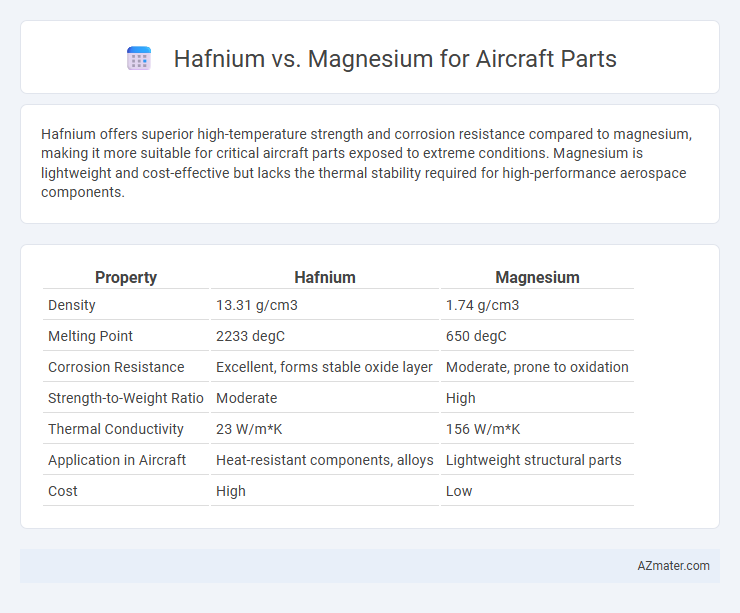Hafnium offers superior high-temperature strength and corrosion resistance compared to magnesium, making it more suitable for critical aircraft parts exposed to extreme conditions. Magnesium is lightweight and cost-effective but lacks the thermal stability required for high-performance aerospace components.
Table of Comparison
| Property | Hafnium | Magnesium |
|---|---|---|
| Density | 13.31 g/cm3 | 1.74 g/cm3 |
| Melting Point | 2233 degC | 650 degC |
| Corrosion Resistance | Excellent, forms stable oxide layer | Moderate, prone to oxidation |
| Strength-to-Weight Ratio | Moderate | High |
| Thermal Conductivity | 23 W/m*K | 156 W/m*K |
| Application in Aircraft | Heat-resistant components, alloys | Lightweight structural parts |
| Cost | High | Low |
Introduction to Hafnium and Magnesium in Aerospace
Hafnium and magnesium are critical metals used in aerospace manufacturing due to their unique properties. Hafnium offers exceptional heat resistance and corrosion protection, making it ideal for high-temperature engine components, while magnesium is prized for its lightweight nature and strength-to-weight ratio, essential for reducing aircraft weight. The combination of hafnium's thermal stability and magnesium's lightweight properties contributes to improved fuel efficiency and durability in modern aircraft parts.
Material Properties: Hafnium vs Magnesium
Hafnium exhibits exceptional corrosion resistance, high melting point of 2233degC, and superior mechanical strength, making it ideal for high-temperature aircraft components exposed to extreme conditions. Magnesium offers a lightweight advantage with a melting point of 650degC and good strength-to-weight ratio but lacks the high-temperature stability and oxidation resistance of hafnium. Material selection between hafnium and magnesium depends on the critical performance requirements such as thermal endurance, durability, and weight constraints in aerospace applications.
Weight Comparison for Aircraft Applications
Hafnium, with a density of approximately 13.31 g/cm3, is significantly heavier than magnesium, which has a density around 1.74 g/cm3, making magnesium a superior choice for weight-sensitive aircraft parts. Magnesium's lightweight properties contribute to improved fuel efficiency and reduced overall aircraft weight. While hafnium offers excellent strength and corrosion resistance, its weight disadvantage limits its use in applications where minimizing mass is critical.
Strength and Durability Analysis
Hafnium exhibits superior strength and high-temperature durability compared to magnesium, making it ideal for critical aircraft components exposed to extreme conditions. Magnesium, while lightweight and corrosion-resistant, lacks the mechanical robustness and thermal stability required for high-stress aircraft parts. The exceptional tensile strength and resistance to oxidation of hafnium alloys contribute significantly to enhanced longevity and reliability in aerospace applications.
Corrosion Resistance in Aerospace Environments
Hafnium exhibits superior corrosion resistance compared to magnesium in aerospace environments due to its stable oxide layer that protects against oxidation and chemical degradation. Magnesium alloys, while lightweight, are more prone to corrosion from moisture and salty air, necessitating additional protective coatings or treatments. The enhanced durability of hafnium under extreme conditions makes it a preferred choice for critical aircraft components exposed to harsh atmospheric elements.
Thermal Stability and Performance
Hafnium offers superior thermal stability compared to magnesium, maintaining structural integrity at temperatures above 1500degC, which is crucial for high-performance aircraft parts exposed to extreme heat. Magnesium, while lightweight and corrosion-resistant, has a melting point around 650degC, limiting its use in high-temperature aerospace applications. Hafnium's high melting point and excellent oxidation resistance enhance aircraft part durability and performance under thermal stress conditions.
Cost Implications of Hafnium and Magnesium
Hafnium, with its high density and exceptional corrosion resistance, generally incurs higher material and processing costs compared to magnesium, which is lightweight and widely available. Magnesium offers significant cost advantages due to lower raw material prices and easier machining, making it a preferred choice for large-scale aircraft components where weight reduction is critical. However, Hafnium's performance in high-temperature environments can justify its higher expense in specialized aerospace applications that demand superior durability and heat resistance.
Manufacturing and Machinability Differences
Hafnium offers superior heat resistance and corrosion stability compared to magnesium, making it ideal for high-temperature aircraft components such as turbine blades and engine parts. Magnesium excels in lightweight applications due to its low density and excellent machinability, which reduces manufacturing time and tool wear during CNC machining. The machinability differences are significant; magnesium's softer nature allows for faster cutting speeds and less tool strain, whereas hafnium requires specialized machining techniques to manage its hardness and maintain dimensional precision.
Environmental Impact and Sustainability
Hafnium exhibits superior corrosion resistance and high melting point, which contributes to longer aircraft part lifespans and reduced material waste compared to magnesium. Magnesium, while lightweight and abundant, poses environmental challenges due to its high energy consumption in extraction and susceptibility to oxidation, potentially leading to higher maintenance and replacement rates. Choosing hafnium over magnesium can enhance sustainability by minimizing frequent part replacements and lowering the overall carbon footprint associated with aircraft manufacturing and maintenance.
Conclusion: Choosing the Right Material for Aircraft Parts
Hafnium offers superior high-temperature strength, corrosion resistance, and oxidation stability crucial for aircraft parts exposed to extreme conditions, while magnesium provides lightweight properties beneficial for reducing overall aircraft weight but with lower strength and durability. Selecting the right material depends on the specific aircraft part's performance requirements, operating environment, and weight constraints. Prioritizing hafnium for critical components ensures enhanced safety and longevity, whereas magnesium suits non-structural parts where weight savings are paramount.

Infographic: Hafnium vs Magnesium for Aircraft Part
 azmater.com
azmater.com